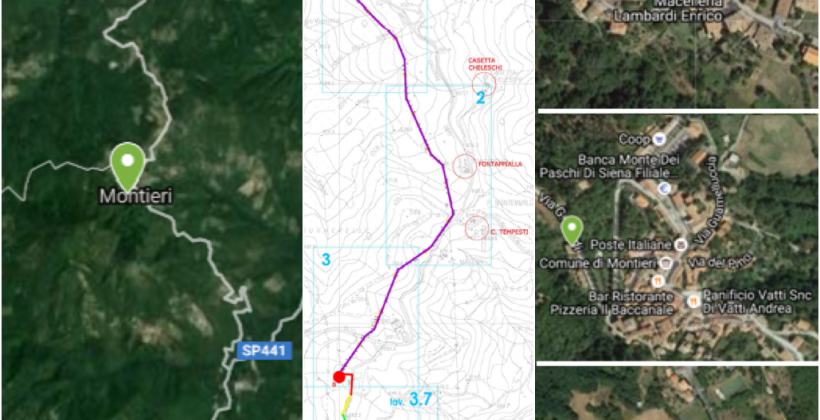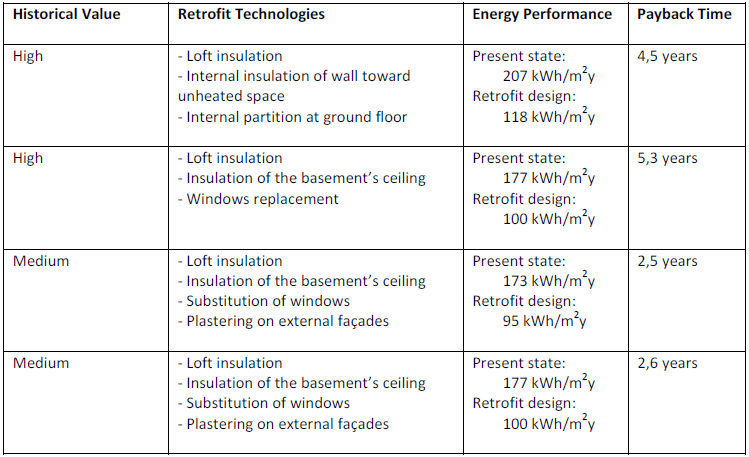
Location
Description
Montieri is situated in central Italy, about 2 hours’ drive from Florence. The well-preserved historical town stretches over 108 km² and has a population of 1216 people. It features a number of very old buildings with distinctive characteristics, such as stone masonry walls (filaretto natural stonework) and unusual arches and openings. These buildings are listed by the local authority as important cultural and historical symbols of Montieri. As a result, the town needed to develop innovative solutions to reduce the primary energy consumption of these buildings without carrying out major retrofitting works.
The focus of the interventions in Montieri was on the construction of a new district heating system based on geothermal energy, with a total capacity of 6 MW. Refurbishments, photovoltaic and solar thermal installations were additional measures carried out in the scope of the GEOCOM project.
Map of interventions in Montieri (Montiery, Travale, Boccheggiano) (Photo: GEOCOM, google) View on Montieri Picture 1 – Geothermal spot at Montieri Picture 2 - City centre of Montieri Picture 3 – Geothermal plant at Montieri Picture 4 - Model of the geothermal plant Picture 5 – Building of historical value has been retrofitted
Documents
Demo Site Expected Impact
Overall a gross floor area of 1986 m² was refurbished in Montieri. As a result of the energy-efficiency interventions, the energy needs were reduced from 214 kWh/m²/yr (business as ususal) to 75 kWh/m²/yr.
The data provided by the project showed that the refurbishment of the buildings resulted in final energy savings amounting to 96 MWh/yr. According to SCIS calculations, the change to the energy carriers, together with the buildings’ upgrade, achieved 148 MWh/yr of primary energy savings for those interventions affecting the buildings.
The primary energy savings for all the interventions within the demo site increase to 4950 MWh/yr while the CO2 reduction amounts to 3507 tonnes each year.
Site facts and figures
- Estimated population involved: territory of Montieri 1.200, inhabitants of Montieri: 435 (status: 2010)
- Approx. geographical area coverage: 396 ha
- Approx. energy saving: 1.172,6 TEP
- Approximate energy from RES: 25 %
Technologies
Technologymix
A highly innovative geothermal district heating system (Picture 1) with a high-enthalpy fluid is implemented, which will provide energy for about 425 dwellings. The total heated building volume is 110,000 m³. The corresponding required energy accounts to 5,500 MWh per year.
Retrofitting of selected dwellings by using integrated approaches and techniques plays an important role. Montieri represents a challenging site for defining and testing a qualitative architectural integration of renewable energy technologies and retrofitting measures. In such an architectural heritage the potential for intervention at the building envelope level is quite limited. It is a highly complex task, because most of the buildings at the town are listed and date from the 16th century (Picture 2). Only natural materials and methods are acceptable, which are in conformity with the medieval city structure. A fifth of the total dwellings in Montieri are subject of being retrofitted during the project. The measures include reducing the energy demand by insulation and replacing windows and connecting the buildings to the geothermal district-heating network to make their heat supply 100% free of fossil fuel.
Furthermore photovoltaics of 8.5 kWpeak will be installed as the main electricity source for the renewed public lighting system. Solar thermal collectors with 42.5 m² will be installed as primary heating and DHW source mainly for those distant apartments, which are not connected to the district heating system.
Geothermal District Heating Network
Montieri sets a new, ambitious example for Central-Eastern European countries, where higher temperature fluids (medium/high enthalpy) may also be recovered (although at significantly higher investment costs). With the help of innovative technological solutions the feasibility of tapping into medium enthalpy resources will be demonstrated. Challenges include high pressure (15-20 bar) and temperature (200-215 °C). The flux of the geothermal medium is 50-60 tons per hour. As there is a 170 m elevation difference between the steam/hot water exchanger (530 m asl.) and the central exchanger (700 m asl.) special measures have to be taken. A water pressure of 2 bars is required to pressurize the circuit (including the central exchanger, where jars of expansion will be installed) and in order to keep the circuit superheated. Picture 3 shows part of the geothermal plant and Picture 4 a model of it.
Retrofitting ancient buildings
There will be a challenge in defining and testing a qualitative architectural integration of renewable energy technologies and retrofitting measures, because within the scope of this architectural heritage the potential for intervention at the building envelope level is quite limited (Picture 5). Only natural materials and methods are acceptable, which are in conformity with the medieval city structure. Twenty percent of all dwellings in Montieri will be retrofitted during the project. Different measures and economic performances have been examined (Table 1).

Table 1 – Defining different measures of retrofit depending on the historical value
Buildings and energy
The following interventions were implemented in Montieri as part of the GEOCOM project:
Energy efficiency in buildings
- Retrofitting the building envelope
- Retrofitting the walls
- Replacing windows and doors
- Building integrated renewable energy sources
- Photovoltaics
- Thermal collectors
Energy systems integration
- Deep geothermal energy
- Construction of a geothermal district heating network
The payback period calculated by SCIS for the whole demonstration site of Montieri is 28 years. Regarding just the new geothermal district heating network, the payback period exceeds 30 years. The financial analysis shows that a profitability of the project is not given due to the high investments in comparison to the low-energy cost savings. This however does not reflect non-monetary benefits that might occur during the implementation.
Lessons learnt
The following information has been gathered as part of the CONCERTO Premium policy research.
Benefits of CONCERTO:
Key benefits:
Benefits of district heating are the security of heating and DHW for the city centre, more winter indoor comfort. Benefits of retrofit activity is a lower energy demand for public buildings and a better indoor comfort. The same will be for those households who will undertake retrofitting activities on their houses.
Skill development:
A PHD theses was written about the energy conscious refurbishment of small historic towns taking Montieri and Geothermal Community project’s actions as main case study.
Local economic effects:
At least 1 person/year in the municipality of Montieri were required for the planning and construction of the CONCERTO project.
Barriers encountered:
Administrative barriers:
Design construction of the district heating met some problems with the tender phase because the procedure for the assignment of the enterprise that is making the works was complicated. A person of the technical office of the municipality was asked to follow the administrative procedure for 100% of his working time.
Legacy – follow-on projects:
One of the neighbor municipalities expressed the interest in the involvement in a European project to develop actions for improving the use of geothermal energy and increasing energy efficiency following the example of Geothermal Communities project.
The CONCERTO approach
The main Concerto activities at Montieri are:
- Implementing a highly innovative geothermal district heating system by using high-enthalpy fluid
- Retrofitting of selected dwellings by using integrated approaches and techniques
Highlights
With the help of the innovative technological solutions the feasibility of tapping into medium enthalpy resources will be demonstrated. In the project number of dwellings served by the district heating is 425, with a total heated volume of 110,000 m3. The value of energy required and produced by the geothermal system is estimated to be 5,500 kW (20,000 GJ).
Building aspects
- Building Energy Services
- heating and DHW
- Installed Renewable Energy Sources
- photovoltaic - building integrated
- Installed Renewable Energy Sources
- solar thermal collectors
- Technology used to supply the buildings
- district heating (DH) network
Thematic Field
- Refurbished Building(s)
